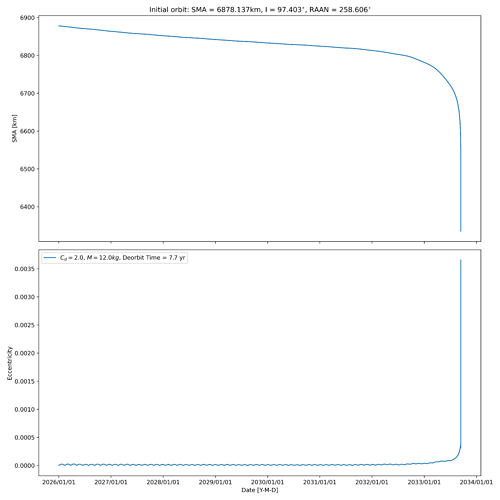I am having a few issues with my DSST Propagator, specifically around atmospheric drag and third bodies. When I add the Moon as a third body my spacecraft will orbit for ~8.78 years before giving me the following error
JavaError Traceback (most recent call last)
Cell In [9], line 1
----> 1 proptagate_orbit(
2 ra=None,
3 cd=1.5,
4 satellite_mass=14.0,
5 area=0.103,
6 epochDate=AbsoluteDate(2026, 1, 1, TimeScalesFactory.getUTC()),
7 inclination=None,
8 time_steps_per_day=5,
9 )
Cell In [8], line 93, in proptagate_orbit(ra, cd, satellite_mass, area, inclination, epochDate, max_days, time_steps_per_day)
91 while (time*u.s).to(u.day).value <= max_days:
92 new_date = extrapDate.shiftedBy(float(dt))
---> 93 sma = dsstProp.propagate(
94 extrapDate, new_date
95 ).getA()
96 smas.append(sma)
97 time += dt
JavaError: <super: <class 'JavaError'>, <JavaError object>>
Java stacktrace:
org.orekit.errors.OrekitIllegalArgumentException: hyperbolic orbits cannot be handled as org.orekit.orbits.EquinoctialOrbit instances
at org.orekit.orbits.EquinoctialOrbit.<init>(EquinoctialOrbit.java:179)
at org.orekit.orbits.EquinoctialOrbit.<init>(EquinoctialOrbit.java:143)
at org.orekit.orbits.OrbitType$3.mapArrayToOrbit(OrbitType.java:449)
at org.orekit.orbits.OrbitType$3.mapArrayToOrbit(OrbitType.java:405)
at org.orekit.propagation.semianalytical.dsst.DSSTPropagator$MeanPlusShortPeriodicMapper.mapArrayToState(DSSTPropagator.java:1032)
at org.orekit.propagation.integration.StateMapper.mapArrayToState(StateMapper.java:169)
at org.orekit.propagation.integration.AbstractIntegratedPropagator$ConvertedMainStateEquations.computeDerivatives(AbstractIntegratedPropagator.java:754)
at org.hipparchus.ode.ExpandableODE.computeDerivatives(ExpandableODE.java:134)
at org.hipparchus.ode.AbstractIntegrator.computeDerivatives(AbstractIntegrator.java:265)
at org.hipparchus.ode.nonstiff.EmbeddedRungeKuttaIntegrator.integrate(EmbeddedRungeKuttaIntegrator.java:252)
at org.orekit.propagation.integration.AbstractIntegratedPropagator.integrateDynamics(AbstractIntegratedPropagator.java:477)
at org.orekit.propagation.integration.AbstractIntegratedPropagator.propagate(AbstractIntegratedPropagator.java:425)
However, when I remove the Moon third body, it only propagates for ~1.74yrs and gives me the following error
JavaError Traceback (most recent call last)
Cell In [11], line 1
----> 1 proptagate_orbit(
2 ra=None,
3 cd=1.5,
4 satellite_mass=14.0,
5 area=0.103,
6 epochDate=AbsoluteDate(2026, 1, 1, TimeScalesFactory.getUTC()),
7 inclination=None,
8 time_steps_per_day=5,
9 )
Cell In [10], line 93, in proptagate_orbit(ra, cd, satellite_mass, area, inclination, epochDate, max_days, time_steps_per_day)
91 while (time*u.s).to(u.day).value <= max_days:
92 new_date = extrapDate.shiftedBy(float(dt))
---> 93 sma = dsstProp.propagate(
94 extrapDate, new_date
95 ).getA()
96 smas.append(sma)
97 time += dt
JavaError: <super: <class 'JavaError'>, <JavaError object>>
Java stacktrace:
org.orekit.errors.OrekitException: no solar activity available at 2042-02-15T20:49:09.94163531064987Z, data available only in range [1998-09-01T00:00:00.000Z, 2041-10-01T00:00:00.000Z]
at org.orekit.models.earth.atmosphere.NRLMSISE00.getDensity(NRLMSISE00.java:1158)
at org.orekit.forces.drag.DragForce.acceleration(DragForce.java:80)
at org.orekit.propagation.semianalytical.dsst.forces.AbstractGaussianContribution$IntegrableFunction.value(AbstractGaussianContribution.java:1003)
at org.orekit.propagation.semianalytical.dsst.forces.AbstractGaussianContribution$GaussQuadrature.basicIntegrate(AbstractGaussianContribution.java:1472)
at org.orekit.propagation.semianalytical.dsst.forces.AbstractGaussianContribution$GaussQuadrature.integrate(AbstractGaussianContribution.java:1383)
at org.orekit.propagation.semianalytical.dsst.forces.AbstractGaussianContribution.getMeanElementRate(AbstractGaussianContribution.java:388)
at org.orekit.propagation.semianalytical.dsst.forces.AbstractGaussianContribution.getMeanElementRate(AbstractGaussianContribution.java:300)
at org.orekit.propagation.semianalytical.dsst.DSSTPropagator$Main.elementRates(DSSTPropagator.java:1173)
at org.orekit.propagation.semianalytical.dsst.DSSTPropagator$Main.computeDerivatives(DSSTPropagator.java:1152)
at org.orekit.propagation.integration.AbstractIntegratedPropagator$ConvertedMainStateEquations.computeDerivatives(AbstractIntegratedPropagator.java:758)
at org.hipparchus.ode.ExpandableODE.computeDerivatives(ExpandableODE.java:134)
at org.hipparchus.ode.AbstractIntegrator.computeDerivatives(AbstractIntegrator.java:265)
at org.hipparchus.ode.nonstiff.AdaptiveStepsizeIntegrator.initializeStep(AdaptiveStepsizeIntegrator.java:226)
at org.hipparchus.ode.nonstiff.EmbeddedRungeKuttaIntegrator.integrate(EmbeddedRungeKuttaIntegrator.java:226)
at org.orekit.propagation.integration.AbstractIntegratedPropagator.integrateDynamics(AbstractIntegratedPropagator.java:477)
at org.orekit.propagation.integration.AbstractIntegratedPropagator.propagate(AbstractIntegratedPropagator.java:425)
I am confused as to why the Third body has such a large impact, and why it matters that there isn’t data for 2042, when I am trying to propagate in 2027. I have also noticed that if I change the minStep, maxStep, and positionTolerance to be much smaller this problem does not persist.
deorbits_notebook.ipynb (7.1 KB)
I have attached the notebook that I am using to run this. Can anyone provide any clarification to why this is happening, or if I am doing something incorrectly.
